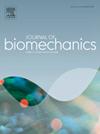Screw pullout strength in osteoporotic bone: A comparative study of synthetic femur surrogates
IF 2.4
3区 医学
Q3 BIOPHYSICS
引用次数: 0
Abstract
Synthetic bone models are frequently used in biomechanical research to assess the fixation strength of implants. Due to their inherent material properties they often overestimate fixation performance − especially in osteoporotic bone, where reduced trabecular density and cortical thickness diminish fixation strength. This study aimed to evaluate new custom-made polyurethane resin bone (PuReBone) surrogates designed to replicate mechanical characteristics of osteoporotic human femora. Their screw pullout performance was benchmarked against human femurs, standard commercial surrogates, and epoxy tubes.
Custom-made polyurethane resin-based surrogates were evaluated in screw pullout experiments using 4.5 mm cortical screws. Their mechanical performance was compared to osteoporotic human femora, a widely used commercial synthetic surogate (Sawbones), and Krülit epoxy tubes. Pullout force and displacement, failure patterns and cortical thickness were analyzed to assess the biomechanical performance of PuReBone.
Pullout forces of PuReBone with a hollow intramedullary canal (855 ± 307 N) were in close agreement with values reported in the literature for osteoporotic human bone (835 ± 444 N, p = 1.000), whereas our experimental results for epoxy-based surrogates (1,905 ± 375 N, p < 0.001) and Krülit (3,234 ± 291 N, p < 0.001) showed significantly higher values. Displacement at failure and stiffness differed across surrogates, with PuReBone showing similar values to the commercial epoxy-based surrogates but lower stiffness than Krülit.
Concluding, PuReBone represents a promising alternative to current synthetic bone models for biomechanical testing of screw pullout in osteoporosis research. Its ability to more accurately replicate osteoporotic bone mechanics enhances the reliability of orthopaedic implant testing and surgical fixation studies.
骨质疏松性骨的螺钉拔出强度:人造股骨替代物的比较研究
合成骨模型在生物力学研究中经常被用于评估植入物的固定强度。由于其固有的材料特性,它们经常高估固定性能-特别是在骨质疏松性骨中,小梁密度和皮质厚度降低会降低固定强度。本研究旨在评估新型定制聚氨酯树脂骨(PuReBone)替代品,旨在复制骨质疏松症人类股骨的力学特征。他们的螺钉拔出性能以人类股骨、标准商业替代品和环氧树脂管为基准。定制的聚氨酯树脂基替代品在4.5 mm皮质螺钉的拔钉实验中进行评估。将其力学性能与骨质疏松的人类股骨、广泛使用的商业合成代物(Sawbones)和kr环氧树脂管进行比较。通过分析拔出力和位移、失效模式和皮质厚度来评估PuReBone的生物力学性能。PuReBone中空髓内管的拔牙力(855±307 N)与文献报道的骨质疏松症的拔牙力(835±444 N, p = 1.000)非常接近,而我们的环氧树脂代物的实验结果(1905±375 N, p <;0.001)和kr lit(3,234±291 N, p <;0.001)的数值显著增高。不同替代品的失效位移和刚度不同,PuReBone显示的值与商用环氧基替代品相似,但刚度低于kr lit。综上所述,PuReBone是目前用于骨质疏松症研究中螺钉拔出生物力学测试的合成骨模型的一个有希望的替代方案。它能够更准确地复制骨质疏松的骨力学,提高了骨科植入物测试和手术固定研究的可靠性。
本文章由计算机程序翻译,如有差异,请以英文原文为准。
求助全文
约1分钟内获得全文
求助全文
来源期刊

Journal of biomechanics
生物-工程:生物医学
CiteScore
5.10
自引率
4.20%
发文量
345
审稿时长
1 months
期刊介绍:
The Journal of Biomechanics publishes reports of original and substantial findings using the principles of mechanics to explore biological problems. Analytical, as well as experimental papers may be submitted, and the journal accepts original articles, surveys and perspective articles (usually by Editorial invitation only), book reviews and letters to the Editor. The criteria for acceptance of manuscripts include excellence, novelty, significance, clarity, conciseness and interest to the readership.
Papers published in the journal may cover a wide range of topics in biomechanics, including, but not limited to:
-Fundamental Topics - Biomechanics of the musculoskeletal, cardiovascular, and respiratory systems, mechanics of hard and soft tissues, biofluid mechanics, mechanics of prostheses and implant-tissue interfaces, mechanics of cells.
-Cardiovascular and Respiratory Biomechanics - Mechanics of blood-flow, air-flow, mechanics of the soft tissues, flow-tissue or flow-prosthesis interactions.
-Cell Biomechanics - Biomechanic analyses of cells, membranes and sub-cellular structures; the relationship of the mechanical environment to cell and tissue response.
-Dental Biomechanics - Design and analysis of dental tissues and prostheses, mechanics of chewing.
-Functional Tissue Engineering - The role of biomechanical factors in engineered tissue replacements and regenerative medicine.
-Injury Biomechanics - Mechanics of impact and trauma, dynamics of man-machine interaction.
-Molecular Biomechanics - Mechanical analyses of biomolecules.
-Orthopedic Biomechanics - Mechanics of fracture and fracture fixation, mechanics of implants and implant fixation, mechanics of bones and joints, wear of natural and artificial joints.
-Rehabilitation Biomechanics - Analyses of gait, mechanics of prosthetics and orthotics.
-Sports Biomechanics - Mechanical analyses of sports performance.
 求助内容:
求助内容: 应助结果提醒方式:
应助结果提醒方式:


